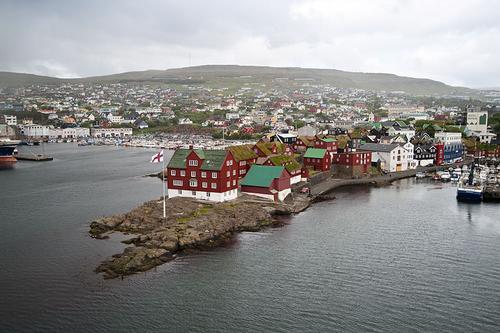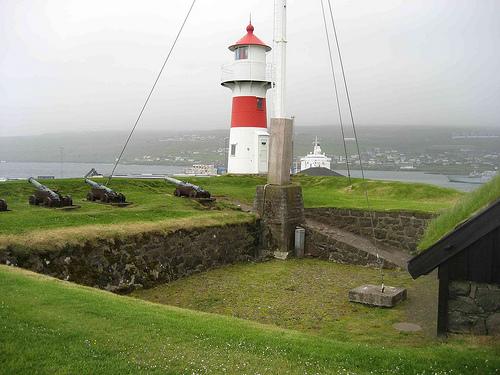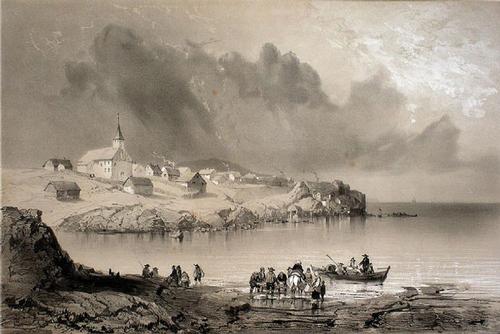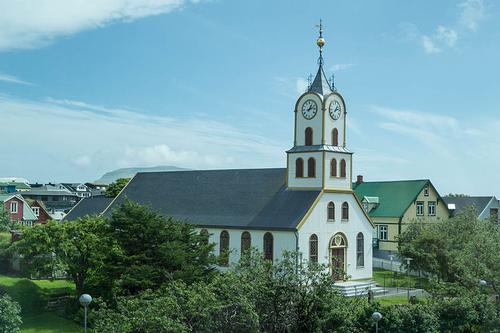FAROE ISLANDS
Tórshavn

Tórshavn
Tórshavn
Tórshavn is the idyllic capital of the Danish Faroe Islands. Tórshavn means Thor's harbour, the god of thunder and lightning in Nordic mythology. Thor's hammer occupies a significant position on the city's coat of arms. Some 19,282 people live in the city. That may not seem much, but when you consider that a total of 48,856 people live on the archipelago, it is quite a lot in comparison.
 TórshavnPhoto:Stig Nygaard CC 2.0 Generic no changes made
TórshavnPhoto:Stig Nygaard CC 2.0 Generic no changes made
Location
Tórshavn is located on the east coast of the island of Streymoy. This is the largest island in the Faroe Island group. To the northwest of the city is Mount Húsareyn, which is 347 metres high, and to the southwest is Mount Kirkjubøreyn, which is 350 metres high. Tórshavn has an area of 185 km².
Weather
The weather in Tórshavn is best described as a temperate maritime climate, which is of course due to the proximity of the Gulf Stream. The summers are cool and the winters fairly mild with temperatures barely dropping below freezing. In the summer, temperatures are between 7°C and 14°C. The weather can be very inclement in Tórshavn, as it is often stormy and there is little sunshine.
History
Around 850, the Vikings settled in the area around Tórshavn. They immediately christened the city the capital of the area and it remains so to this day. The Viking era ended in 1035. In 1271, the royal trading monopoly was established in Tórshavn by the Norwegian Crown. As early as the 12th century, there was trade between the Faroe Islands and Norway. Later, when Norway was under Denmark, there was trade with Denmark.
According to the history books, Tórshavn did not really get a built-up area until after the Protestant Reformation in 1539. Out of the need to protect the city and its trade from pirate attacks, a small fortress was built in 1580 by the Faroese naval hero Magnus Heinason on the north side of the harbour. This was followed by the construction of more small forts on Tinganes, Tórshavn's peninsula. In 1584 Tórshavn had only 101 inhabitants. The population consisted of three strata. The first layer was peasant families and servants, the second consisted of traders and officials, and the landless proletariat who moved to the capital in search of work formed the third layer.
 Fortress of TórshavnPhoto: David Stanley CC 2.0 Generic no changes made
Fortress of TórshavnPhoto: David Stanley CC 2.0 Generic no changes made
In 1655, the Danish King Frederick III handed over the Faroe Islands to his favourite statesman, Kristoffer Gabel. This was the start of a black period in the history of the archipelago. Gabel oppressed the inhabitants in various ways. He had a trade monopoly and he set the prices for all goods arriving in the harbour. Thus, imported goods remained expensive and limited for ordinary citizens. So there was a lot of discontent among the population. In 1673, there was a big fire in Tinganes caused by an explosion in a gunpowder warehouse.
In 1709 the trade monopoly became a royal monopoly and that meant an improvement of conditions for the inhabitants of Tórshavn. Three times a year goods were brought from Copenhagen to Tórshavn. The town fared better until a plague of smallpox broke out in 1709. Of the total of 300 inhabitants, 250 died. Torshavn around 1839Photo: Public domain
Torshavn around 1839Photo: Public domain
Yet after the plague, Tórshavn quickly flourished again under the leadership of Niels Ryberg. Thanks to the Franco-English conflict, smuggling was possible between Tórshavn and England. Ryberg was the first to begin trading in fish; he experimented with salted herring and cod. Tórshavn became a true trading centre. At first, the capital was the only place where trade was allowed, but in 1856, trade was allowed on all Faroe Islands.
At the beginning of the 20th century, Tórshavn's position became increasingly significant and the city grew to become the administrative, economic and cultural centre of the archipelago. During World War II, the Faroe Islands were occupied by the United Kingdom.
Sights
Tórshavn Cathedral is the second oldest church in the archipelago. The church is located in the old town centre in northern Tinganes. It is a Lutheran cathedral that has been the seat of the bishop of the Faroe Islands since 1990. The history of the church goes back a long way, initially during the Middle Ages there was a house of prayer on the site where the church is now found. In 1609, a real church was built on the site by order of King Christian IV. In 1788, the church was rebuilt and in 1865, the cathedral was given a whole new look. The present church is a true masterpiece of stone.
 Cathedrall TórshavnPhoto: Henrik Dvergsdal CC 3.0 Unported no changes made
Cathedrall TórshavnPhoto: Henrik Dvergsdal CC 3.0 Unported no changes made
Skansin Fortress is situated on a hill next to Tórshavn harbour. It was built in 1580 to protect the city from pirates. In 1780, the fort was expanded. During the Second World War, the fort served as a military base for the British. There are several cannons from the period of the British occupation as well as from the Danish period. The fort offers a fairytale view of the harbour, the surrounding landscape and the island of Nolsoy.
The local Historical Museum exhibits archaeological and religious artifacts, models of old ships, agricultural tools and household items, and also focuses on the Viking Age. There is an open-air museum in Tórshavn, which is a small farmhouse that paints a picture of everyday life in the 13th and 14th centuries.
Tips
The Museum of Natural History, with its beautiful botanical garden with more than 150 Faroese plant species, is worth visiting.
Useful links Tórshavn
BBC Country ProfilesWorld Fact Book Explore all Countries
How to call
Last updated December 2025
Copyright: Team - The World of Info